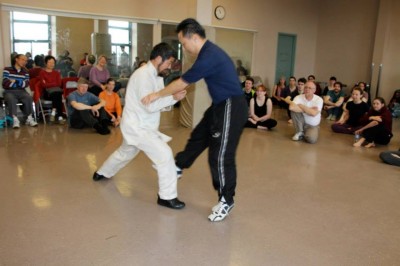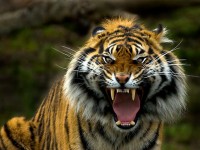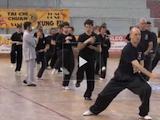 |
Rachel, Daniel, and James did an excellent job organizing an Open House and Workshop for the Weekend of April 05-06, 2014. On a beautiful spring morning, more than 50 people gathered to learn about the Chen Style Practical Method and to meet one of its distinguished proponents, Master Joseph Chen Zhonghua. |
The event was made possible with the support of Daniel’s group at the University of Ottawa and the Ottawa Tai Chi Chuan Association (OTCA). Over the course of two and a half hours, the audience was immersed in the history and philosophy of Taijiquan, leading to the development of the Practical Method by Master Hong Junsheng.
Master Chen opened the demonstration by performing the first section of the Yilu. Following this, Daniel’s students showcased a group form, and later, students John (Ottawa) and Ken (Toronto) performed the complete Yilu. After the Open House, a series of workshops took place. Below are my observations from the weekend. A video summary for this open house is now available (for members only). In 2025, I compiled and edited the transcript for the open house.
Questions and Answers
Near the end of the Open House, Master Chen invited the audience to ask questions. You can watch the video of the Q&A session here. Two questions stood out to me—ones that are frequently asked by beginners worldwide.
Q1. What is the “best” style (Yang, Chen, Wu, Wu (Hao), Sun) to practice?
Master Chen responded politely and refrained from directly promoting the Practical Method in his answer. Instead, he emphasized that Taijiquan is founded on a single underlying principle, with different styles reflecting the unique signatures of individual teachers.
I understood the question as an inquiry into the variations in Yilu practice among different branches of the Chen style. I found Master Hong’s answer satisfying. According to Hong, his teacher, Chen Fake, continuously refined Yilu throughout his lifetime. The guiding principle behind these changes is best expressed in Chen Fake’s own words:
“This set of Taijiquan does not contain a single useless technique. Every movement was carefully designed with purpose.”“这套拳没有一个动作是空的, 都是有用的。”
“Although there are myriad variations, there is only one underlying principle.”“虽变化万端, 而理为一贯。”
Q2. “How to find the best teacher?”
Master Chen stated that, in the end, everything comes down to fate. He reflects on how fortunate he was to have encountered Master Hong and, later, to have been introduced to Master Feng. In the traditional Chinese and Taoist perspective, it is also a matter of fate that a teacher finds the right student.
However, my personal view is more pragmatic—I believe that by keeping an open mind, one can recognize opportunities when they arise. Based on my own experience, I focus less on the fame and abilities of a teacher and more on the quality of their students. After all, if a teacher’s instruction does not elevate their students, how can I personally benefit from their training?
Regardless of Master Chen Fake’s individual accomplishments, his true legacy lies in his students, such as Master Feng and Master Hong. Likewise, Master Hong has trained students such as Master Chen and Master Li, who are now considered the new torchbearers of the Chen Taijiquan tradition. More recently, I have had the opportunity to meet and observe some of Master Chen’s disciples, including Ronnie Yee, Steve Chan, and Chen Xu. From what I have seen, they are successfully acquiring the skills of their teacher.
Push hands and the eye of the Tiger
The Ottawa group was thrilled by the success of the Open House, and a few audience members stayed on for the workshop. Each Ottawa workshop brings together participants ranging from complete novices to seasoned practitioners of the Practical Method. Having attended several workshops myself, I’ve been able to observe the steady progress of different participants over time. It was a true pleasure to practice techniques with students from Toronto, Montreal, and Philadelphia and to witness their improvement since the last workshop.
Push hands is a vital component of Practical Method training, as it serves as a direct test of one’s understanding of its principles. Generally, beginners like myself tend to revert to relying on raw strength rather than applying Taiji principles to elicit a response from an opponent. Fortunately, Master Chen personally demonstrates how each technique should be properly executed in alignment with Taiji principles.
 |
During this phase of push hands training, I had an intriguing realization. In a previous post, I have commented on Master Chen’s push hand’s skills. Feeling more comfortable and energized, I was eager to experience his longer-range techniques. At one point, as he walked by, I happened to touch him from the side. His immediate reaction was both precise and instinctive—he turned and executed a straight-line strike aimed at the bridge of my nose, paired with a stomp toward my knee, stopping just fractions from the target. |
From a martial arts perspective, the technique was nothing short of beautiful. From a personal perspective, my action was about as reckless as the time I petted a tiger (a story for another day). Definitely not an experience for the faint of heart.
By the end of the day, exhaustion had taken its toll—every muscle in my body ached, a clear sign of my limited understanding of the Practical Method.
Indirect Power – Positive and Negative
Indirect power is the foundation of Taijiquan applications. According to Master Chen, this concept—also referred to as Indirect Action or “Structural Power”—operates on the principle that an opponent’s reaction is not triggered at the point of contact but rather elsewhere in the body. In contrast, direct power is exerted immediately at the first point of contact.
In Taijiquan, this point of contact serves as an anchor, hook, or handle, enabling additional actions to take place. A clear analogy for this principle can be found in fishing: the hook catches the fish, but it is the line and reel that ultimately bring it in. Similarly, indirect power in Taijiquan comes in two forms—Positive and Negative—each playing a vital role in the execution of techniques.
Positive Indirect Power
In Taijiquan, Positive Indirect Power operates through nine levels of holds, corresponding to the joints of the human body. These levels are classified based on the number of holds engaged in a given action. Direct power involves only one hold—the point of contact. First-class indirect power engages two holds, second-class indirect power involves three, and so on. At the highest level, eighth-class indirect power incorporates all the joints, maximizing the effect.
 |
Figure 1 illustrates this concept. In the diagram, the opponent remains fixed at position A, gripping an arm at point B. Together, points A and B form the first hold. In conventional combat, engagement occurs along the A-B line, representing direct power.
Through Chen Taiji training, however, you maintain the A-B distance while incorporating additional actions. Introducing movement at the kua (point C) establishes Level 1 indirect power. Further engaging the knee (point D) results in Level 2 indirect power, utilizing three holds. As each joint is progressively activated, the opponent perceives force along the A-B line—not from direct power at A-B but rather from the structural power generated by Chen stylists. Conceptually, each additional level of indirect power corresponds to an increase in effective distance, determined by the involvement of joints. For instance, Level 1 indirect power expands distance to BC, while Level 2 extends it to BD. |
A common challenge in applying indirect power is the tendency to overly focus on direct power—moving the point of contact—while inadvertently allowing unintended movement in other body parts, leading to leakage.
Negative Indirect Power
 |
Negative Indirect Power involves two distinct actions: first, reducing distance, and second, eliciting a reaction. Figure 2 illustrates this concept.In the first step, X and Z represent two points—X corresponding to the Chen Stylist and Z to the opponent. The initial distance between them is X-Z. The Chen Stylist strategically occupies space at Y (for example, by shifting a leg), thereby reducing the X-Z distance by X-Y.
Next, the Chen Stylist capitalizes on this reduced distance to provoke a reaction from the opponent—for instance, by extending a hand. Importantly, this reaction arises not from direct muscle-driven power but from structural power generated by the adjusted positioning. A key challenge in applying Negative Indirect Power is maintaining stability at the point of contact. The opponent must continue to feel in control, unaware of the shifting structural advantage being leveraged against them. |
Indirect Power according to Master Hong
Master Hong, without hesitation, pointed to a large rock nearby and said, ‘Move that rock over here, and I’ll show you.’
Eager to prove his strength, the young man bent down, lifted the heavy rock, and carried it over to Master Hong’s feet. He set it down with a satisfied grunt, ready for an impressive display of martial power.
Master Hong smiled. ‘This is my quan—moving the rock from there to here.’
I have to admit, when I first heard the story, it went completely over my head. But now, I see it—pure, effortless indirect power in action!”
Difficulty in Learning the Practical Method
Master Hong reminded us that to truly learn his quan:
| 還需要,有良朋, 同學拳, 可互助。 | You also need , To have good friends and training partners, Able to help each other practice |
Learning is a shared journey, and experimenting with others enriches understanding.
Workshops provide the perfect opportunity to meet new friends, exchange ideas, and deepen your grasp of the Practical Method.



{ 8 comments… read them below or add one }
Ming, great review article! You summarized it really well with all the critical details that I have missed or that have already grown fuzzy on me. You are indeed Great Article Ming! We are all also privileged to have a great training partner and leader in you. Thanks!
For those who are not aware, there is an update on the wiki entries of Master Chen Zhonghua (http://en.wikipedia.org/wiki/Chen_Zhonghua), on Grandmaster Hong Junsheng (http://en.wikipedia.org/wiki/Hong_Junsheng) and Grandmaster Chen Fake(http://en.wikipedia.org/wiki/Chen_Fake). When you have a chance, please check it out.
As James says, another excellent piece from Great Article Ming (TM)!!
Thanks Ming, your notes will be very useful to me.
Excellent article again Ming! Thanks for taking the time to write it up and submit it. I agree with my esteemed fellow students – you article does sum-up well the key points of the weekend and provides the detail needed to further learning.
I also want to thank you for being a good practice partner.
Does anyone learn with your meathod? It is well thought out and beautifully explained.Yet it seems that it needs to be felt.
Does anyone know of a study group in the Ottawa area practicing this style? I am new to the Ottawa area and would love to participate.
You can contact James Tam or Rachelle Bergeron from Ottawa – Chen Style Taijiquan Practical Method
https://www.facebook.com/groups/463162150390351/
Asim,
The Ottawa group practice is on the weekend, Saturdays 1:00-300 p.m. We will be moving to a new location soon at Tom Brown Arena, 141 Bayview Rd and it won’t commence till October 25. As well, there is going to be a new class organized by the Ottawa Tai Chi Chuan Association (OTCA), beginning Sept. 28, where I will teach the Practical Method Yilu (hand form) 9:30-11:30 a.m. Finally, there will be an OTCA Open House on Sept 7 (9-11:30am, Adult High School, 300 Rochester) where there will demos of the several styles of tai chi that will be taught by different instructors at the same school location.
James Tam
Asim, we have a practice group in Ottawa, ON that meets Saturdays 1-3 p.m. at Tom Brown Arena at Bayview (beginning in October). There will be a NEW class beginning in September at the Adult High School, 300 Rochester St., 9:30-11:30 a.m. on Saturdays. Please check the Ottawa Taichi Chuan Association’s (OTCA) calendar at http://www.ottawa-taichi.ca/calendar for REGISTRATION and OPEN HOUSE dates. Please contact me (jtam007@hotmail.ca) for more details about (1) the new Practical Method class and (2) the ongoing practice in Ottawa. Rachelle at rachelle.bergeron@rogers.com can also provide you with details of the practice group as well as the Master Chen Zhonghua workshops that she hosts.
James